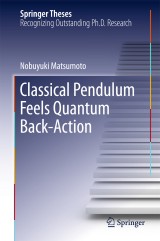Details

Classical Pendulum Feels Quantum Back-Action
Springer Theses
|
96,29 € |
|
| Verlag: | Springer |
| Format: | |
| Veröffentl.: | 01.12.2015 |
| ISBN/EAN: | 9784431558828 |
| Sprache: | englisch |
Dieses eBook enthält ein Wasserzeichen.
Beschreibungen
<p>In this thesis, ultimate sensitive measurement for
weak force imposed on a suspended mirror is performed with the help of a laser
and an optical cavity for the development of gravitational-wave detectors.
According to the Heisenberg uncertainty principle, such measurements are
subject to a fundamental noise called quantum noise, which arises from the
quantum nature of a probe (light) and a measured object (mirror). One of the
sources of quantum noise is the quantum back-action, which arises from the
vacuum fluctuation of the light. It sways the mirror via the momentum
transferred to the mirror upon its reflection for the measurement. The author
discusses a fundamental trade-off between sensitivity and stability in the
macroscopic system, and suggests using a triangular cavity that can avoid this
trade-off. The development of an optical triangular cavity is described and its
characterization of the optomechanical effect in the triangular cavity is
demonstrated. As a result, for the first time in the world the quantum back-action
imposed on the 5-mg suspended mirror is significantly evaluated. This work
contributes to overcoming the standard quantum limit in the future.</p>
weak force imposed on a suspended mirror is performed with the help of a laser
and an optical cavity for the development of gravitational-wave detectors.
According to the Heisenberg uncertainty principle, such measurements are
subject to a fundamental noise called quantum noise, which arises from the
quantum nature of a probe (light) and a measured object (mirror). One of the
sources of quantum noise is the quantum back-action, which arises from the
vacuum fluctuation of the light. It sways the mirror via the momentum
transferred to the mirror upon its reflection for the measurement. The author
discusses a fundamental trade-off between sensitivity and stability in the
macroscopic system, and suggests using a triangular cavity that can avoid this
trade-off. The development of an optical triangular cavity is described and its
characterization of the optomechanical effect in the triangular cavity is
demonstrated. As a result, for the first time in the world the quantum back-action
imposed on the 5-mg suspended mirror is significantly evaluated. This work
contributes to overcoming the standard quantum limit in the future.</p>
Introduction.- Theory of Optomechanics.- Application of Optomechanics.- Optical Torsional Spring.- Experimental Setup.- Experimental Results.- The Future.- Conclusions.
<p>In this thesis, ultimate sensitive measurement for
weak force imposed on a suspended mirror is performed with the help of a laser
and an optical cavity for the development of gravitational-wave detectors.
According to the Heisenberg uncertainty principle, such measurements are
subject to a fundamental noise called quantum noise, which arises from the
quantum nature of a probe (light) and a measured object (mirror). One of the
sources of quantum noise is the quantum back-action, which arises from the
vacuum fluctuation of the light. It sways the mirror via the momentum
transferred to the mirror upon its reflection for the measurement. The author
discusses a fundamental trade-off between sensitivity and stability in the
macroscopic system, and suggests using a triangular cavity that can avoid this
trade-off. The development of an optical triangular cavity is described and its
characterization of the optomechanical effect in the triangular cavity is
demonstrated. As a result, for the first time in the world the quantum back-action
imposed on the 5-mg suspended mirror is significantly evaluated. This work
contributes to overcoming the standard quantum limit in the future.</p>
weak force imposed on a suspended mirror is performed with the help of a laser
and an optical cavity for the development of gravitational-wave detectors.
According to the Heisenberg uncertainty principle, such measurements are
subject to a fundamental noise called quantum noise, which arises from the
quantum nature of a probe (light) and a measured object (mirror). One of the
sources of quantum noise is the quantum back-action, which arises from the
vacuum fluctuation of the light. It sways the mirror via the momentum
transferred to the mirror upon its reflection for the measurement. The author
discusses a fundamental trade-off between sensitivity and stability in the
macroscopic system, and suggests using a triangular cavity that can avoid this
trade-off. The development of an optical triangular cavity is described and its
characterization of the optomechanical effect in the triangular cavity is
demonstrated. As a result, for the first time in the world the quantum back-action
imposed on the 5-mg suspended mirror is significantly evaluated. This work
contributes to overcoming the standard quantum limit in the future.</p>
Nominated as an outstanding contribution by The University of Tokyo's Physics Department in 2014 Describes precise force measurement imposed on a suspended mirror and the effect of the quantum back-action Introduces a newly developed technique on how to
trap the macroscopic mirror by laser, free from the thermal bath Includes supplementary material: sn.pub/extras
trap the macroscopic mirror by laser, free from the thermal bath Includes supplementary material: sn.pub/extras

















